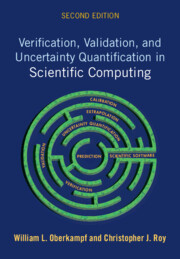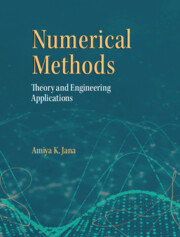Refine search
Actions for selected content:
1945 results in Engineering mathematics and programming
3 - Modeling and Computational Simulation
- from Part I - Fundamental Concepts
-
- Book:
- Verification, Validation, and Uncertainty Quantification in Scientific Computing
- Published online:
- 22 March 2025
- Print publication:
- 03 April 2025, pp 75-132
-
- Chapter
- Export citation
8 - Iterative Error
- from Part III - Solution Verification
-
- Book:
- Verification, Validation, and Uncertainty Quantification in Scientific Computing
- Published online:
- 22 March 2025
- Print publication:
- 03 April 2025, pp 244-267
-
- Chapter
- Export citation
5 - Code Order-of-Accuracy Verification
- from Part II - Code Verification and Software Engineering
-
- Book:
- Verification, Validation, and Uncertainty Quantification in Scientific Computing
- Published online:
- 22 March 2025
- Print publication:
- 03 April 2025, pp 155-192
-
- Chapter
- Export citation
11 - Design and Execution of Model Validation Experiments
- from Part IV - Model Validation and Predictive Capability
-
- Book:
- Verification, Validation, and Uncertainty Quantification in Scientific Computing
- Published online:
- 22 March 2025
- Print publication:
- 03 April 2025, pp 372-432
-
- Chapter
- Export citation
4 - Software Engineering for Scientific Computing
- from Part II - Code Verification and Software Engineering
-
- Book:
- Verification, Validation, and Uncertainty Quantification in Scientific Computing
- Published online:
- 22 March 2025
- Print publication:
- 03 April 2025, pp 135-154
-
- Chapter
- Export citation
Index
-
- Book:
- Verification, Validation, and Uncertainty Quantification in Scientific Computing
- Published online:
- 22 March 2025
- Print publication:
- 03 April 2025, pp 707-712
-
- Chapter
- Export citation
Part IV - Model Validation and Predictive Capability
-
- Book:
- Verification, Validation, and Uncertainty Quantification in Scientific Computing
- Published online:
- 22 March 2025
- Print publication:
- 03 April 2025, pp 327-328
-
- Chapter
- Export citation
14 - Planning and Prioritization in Modeling and Simulation
- from Part V - Planning, Management, and Implementation Issues
-
- Book:
- Verification, Validation, and Uncertainty Quantification in Scientific Computing
- Published online:
- 22 March 2025
- Print publication:
- 03 April 2025, pp 599-626
-
- Chapter
- Export citation
1 - Introduction
-
- Book:
- Verification, Validation, and Uncertainty Quantification in Scientific Computing
- Published online:
- 22 March 2025
- Print publication:
- 03 April 2025, pp 1-18
-
- Chapter
- Export citation

Verification, Validation, and Uncertainty Quantification in Scientific Computing
-
- Published online:
- 22 March 2025
- Print publication:
- 03 April 2025

Numerical Methods
- Theory and Engineering Applications
-
- Published online:
- 31 December 2024
- Print publication:
- 24 October 2024
-
- Textbook
- Export citation
Acknowledgements
-
- Book:
- Numerical Methods
- Published online:
- 31 December 2024
- Print publication:
- 24 October 2024, pp xvii-xviii
-
- Chapter
- Export citation
Chapter 9 - Numerical Integration
-
- Book:
- Numerical Methods
- Published online:
- 31 December 2024
- Print publication:
- 24 October 2024, pp 606-656
-
- Chapter
- Export citation
Chapter 5 - Ordinary Differential Equation: Boundary Value Problem (ODE-BVP)
-
- Book:
- Numerical Methods
- Published online:
- 31 December 2024
- Print publication:
- 24 October 2024, pp 323-407
-
- Chapter
- Export citation
Chapter 7 - Method of Least-Squares
-
- Book:
- Numerical Methods
- Published online:
- 31 December 2024
- Print publication:
- 24 October 2024, pp 503-544
-
- Chapter
- Export citation
Chapter 2 - Linear Algebraic Equation
-
- Book:
- Numerical Methods
- Published online:
- 31 December 2024
- Print publication:
- 24 October 2024, pp 27-133
-
- Chapter
- Export citation
Part IV - Function Approximations
-
- Book:
- Numerical Methods
- Published online:
- 31 December 2024
- Print publication:
- 24 October 2024, pp 501-502
-
- Chapter
- Export citation
Frontmatter
-
- Book:
- Numerical Methods
- Published online:
- 31 December 2024
- Print publication:
- 24 October 2024, pp i-iv
-
- Chapter
- Export citation
Chapter 1 - Introduction to Numerical Method and Process Simulation
-
- Book:
- Numerical Methods
- Published online:
- 31 December 2024
- Print publication:
- 24 October 2024, pp 3-24
-
- Chapter
- Export citation
Chapter 4 - Ordinary Differential Equation: Initial Value Problem (ODE-IVP)
-
- Book:
- Numerical Methods
- Published online:
- 31 December 2024
- Print publication:
- 24 October 2024, pp 217-322
-
- Chapter
- Export citation
